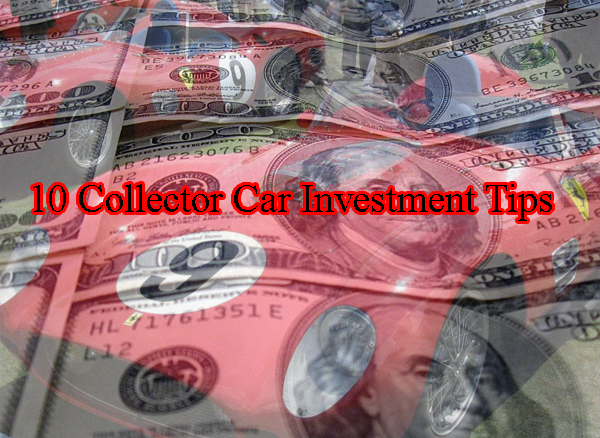Navigating your way through the investment world is always a challenge, and the collector car market is no different. Below are 10 collector car investment tips to help guide you through the sometimes murky waters associated with purchasing that perfect car and achieving what we all desire, a profitable investment.

1. Don’t throw good money at a collector car once you realize you can’t come out ahead.
Sometimes you’re better off cutting your losses and starting over. If you’re the type that wants to win first prize at Pebble Beach money can be a side note to some extent, but if your goal is to retain your positive investment status on a car sometimes it’s best to be honest with yourself and re-evaluate what you’re doing with your car when it seems like you may be headed into the red on it.
2. Always get a thorough pre-purchase inspection before buying any vehicle, especially if you’re buying for investment purposes.
Scott Grundfor Company performs these sorts of inspections for clients all the time and the discovery process before purchase nearly always yields valuable insight into small (and large) important details of the prospective buy.
3. At times it’s best to let your passion and your personal taste define your purchase.
Don’t buy a car just because it seems like a great deal. This isn’t always the case as intelligent “deal finding” can certainly lead to financial gain over the short or long term, however in our experience it’s better to buy something you like than something you don’t, regardless of the finances involved.
4. The age old adage rings true in this arena as in any other, time is money.
Making a “profit” on a collectible car is relative to the time and money you spend. This may sound like a no-brainer but it’s an easy one to forget when you get wrapped up in your calculations on what your car is worth whether purchasing, adding value to a purchase through restorative work or planning for sale.
5. It’s important to insure your collectible investment if you ever plan on driving it.
Not only will this save you out of pocket expense down the line in case of a mishap, but combined with savvy repair shop selection and shrewd negotiations on price, you might just net a gain on an accident.
6. Try to match a car’s trouble spots with areas you can get repaired for little or no money, in other words finding a “one stop shop” so to speak for your sales and repair needs often makes a lot of sense.
It’s often the case that restoration shops (like ours at Scott Grundfor Co.) are the best people to have either purchase or help you sell your car. From our perspective if there are problem areas with the car that need repairing or sprucing up before sale, the car is in the right place at the outset to have the work done. This saves time and money as well as enhancing the value of the car in the market.
7. You can have investment vehicles and you can have weekend race toys.
Generally speaking, don’t try to combine them, or at the very least don’t cross the streams often. Not only is there a danger in losing your positive investment status through a mishap on the road, but there is also the idea that worrying about the safety of your investment probably won’t lead to much fun at the track or on the streets.
8. Never forget that car car values move up and down at seemingly random times just like any other market.
Predicting these swings is more art than science. We’ve tried reasonably successfully in our 30+ years in the car business to predict the future of the market in general and the values of specific cars so we know first hand how difficult it is. A great resource for your investment peace of mind is HAGI (Historic Automobile Group). Being a source of statistics for HAGI, Scott Grundfor Company is well aware of the value HAGI brings to the table in terms of what it can show you in easy to understand terms regarding trends in the market.
9. Understand that buying a rare, low-mileage car for investment purposes has the possibility of meaning that you might not get to drive it as much as you’d like.
A low-mileage car in most cases derives significant value from just that, it’s low-mileage status. You can see where this is going, driving it will slowly devalue it, although putting a few miles on it here and there can be a good thing for the health of the car mechanically.
10. Even a successful automotive investment can have downsides in the end.
It’s not always peaches and cream in the investment world. Sometimes a successful investment requires a certain amount of turmoil and toil in order to come out on the other side with some useful value. Keep in mind that creating success in the collector car arena requires at it’s apex a fine attention to detail, and keeping your eye firmly on the prize of successful investing in automobiles can often have it’s headaches. Basically, expect a little pain with your pleasure.



